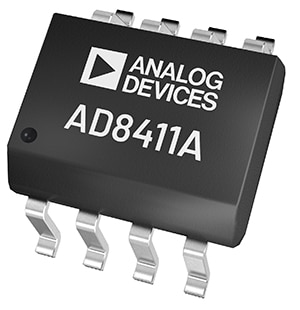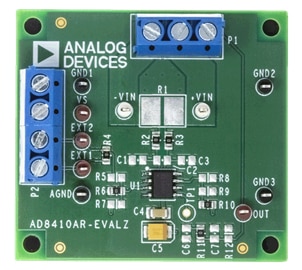Current-Sense Amplifiers for Space-Constrained Applications
Contributed By DigiKey's North American Editors
2024-05-16
Nobody wants bulkier, less efficient electronic products. Producers want designers to figure out how to fit high-performance components into smaller footprints without compromising functionality. The mandate, in other words, is to figure out how to work around the challenges of delivering space-constrained electronic applications with higher accuracy. To that end, current-sense amplifiers are critical to efficient power management, safe operation, and noise-sensitive motor control.
Current-sense amplifiers are widely used in applications such as battery management, overcurrent protection, and fault detection. By measuring and amplifying the voltage drop across a shunt resistor, they play a vital role in circuit protection.
Valued for their small size and low cost, current-sense amplifiers are relatively simple to implement, but there are challenges such as bandwidth limitations, minimizing electrical noise and interference, and high common-mode voltage response. So, choosing the right current-sense amplifier is important for the success of the application.
Determining the right fit starts with identifying key application characteristics:
- The acceptable range of current and the maximum input voltage that can be tolerated by the device
- Environmental conditions and matching reliable performance to the desired temperature range
- Amplifier specifications that meet design constraints, including package size, bandwidth, quiescent current, and accuracy
- Whether to use high-side or low-side current sensing based on the requirements for accuracy, isolation, and ease of implementation
Analog Devices, Inc. (ADI) provides a set of current-sense amplifiers designed for a wide range of applications that perform bidirectional current measurements in various industrial and automotive applications (AEC-Q100 qualified).
The AD8410A and the AD8411A can be used for both AC and DC measurements, are built to operate over a wide temperature range with minimal gain error, and feature a wide operating supply voltage range to accommodate different system requirements. Both utilize an in-package trim core that provides a typical offset drift of ±0.26 µV/°C throughout the operating temperature range and the common-mode voltage range, without the need for chopping and auto-zero clocks which can result in increased noise and other negative impacts.
The AD8410A (Figure 1) has an initial gain of 20 V/V and bandwidth of 2.2 MHz.
 Figure 1: ADI's AD8410A current-sense amplifier. (Image source: Analog Devices, Inc.)
Figure 1: ADI's AD8410A current-sense amplifier. (Image source: Analog Devices, Inc.)
The AD8411A (Figure 2) offers an initial gain of 50 V/V and bandwidth of 2.7 MHz, providing greater flexibility and sensitivity.
 Figure 2: ADI's AD8411A current-sense amplifier. (Image source: Analog Devices, Inc.)
Figure 2: ADI's AD8411A current-sense amplifier. (Image source: Analog Devices, Inc.)
The AD8410A/11A can be used for both high-side and low-side current sensing applications. They are suitable for in-phase or high-side current sensing in various applications such as motor control, bidirectional DC/DC converters, solenoid controls, and power rail monitoring.
They are also applicable for inline current sensing in brushless DC (BLDC) motor drives to measure the current flowing through the motor windings, which is crucial for precise control and performance optimization.
The high-voltage, high-bandwidth current-sense amplifiers are designed for precision current measurement applications, enabling precision torque control, the use of smaller motors and inductors, and smarter motor-driven applications. Utilizing a unique architecture, they can accurately amplify small differential current shunt voltages in the presence of rapidly changing common-mode voltages.
Higher bandwidth allows for more accurate current sensing at high switching frequencies in DC motors, AI servers, and DC/DC converters. This results in higher accuracy of an analog-to-digital converter (ADC), especially in applications with faster pulse width modulation (PWM) switching frequencies and high voltages.
While higher switching frequencies can often result in increased electromagnetic interference (EMI), the AD8410A/11A current-sense amplifiers are designed with features to handle that challenge. They have a high common-mode rejection ratio (CMRR) of 123 dB from −2 V to +70 V to help reject noise and improve EMI performance, making them suitable for applications in noisy electrical environments where EMI might affect their accuracy. They are less prone to intermodulation noise and minimize the use of additional filters.
The AD8410A and the AD8411A share the same package options and features such as overvoltage protection and an enable/disable function. Designed to operate from a single 2.9 V to 5.5 V supply within an industrial temperature range of −40°C to +125°C, they are available in compact, 8-lead Standard Small Outline Package [SOIC_N] and 8-lead Mini Small Outline Package (MSOP) packages with an exposed pad for improved thermal performance.
For motor control systems that require precise current measurement and feedback—such as industrial drives, robotics, or electric vehicles—the AD8410A/11A can handle high common-mode voltages from the motor supply and provide a linear output proportional to the current through the shunt resistor. The AD8411A can be used when a higher gain is needed for smaller shunt resistors or lower current ranges.
Battery management systems that monitor the charge and discharge currents of battery cells or packs can benefit from the ability of the AD8410A/11A to measure the differential voltage across a shunt resistor in series with the battery to provide accurate and fast current sensing. The AD8411A can be used when a higher resolution is required for low current levels or high-capacity batteries.
For power supply monitoring and protection circuits that detect overcurrent or short-circuit conditions, the AD8410A/11A can sense the current flowing through a load or a switch and provide a signal for fault detection or feedback control. The AD8411A can be used when a faster response time or a higher sensitivity is needed for the application.
ADI current-sense amplifier evaluation boards
Designers can take advantage of ADI evaluation boards, which allow designers to evaluate the performance of the AD8410 and AD8411 current-sense amplifiers in different scenarios.
The AD8410AR-EVALZ (SOIC) (Figure 3), AD8410ARM-EVALZ (MSOP), AD8411AR-EVALZ (SOIC), and AD8411ARM-EVALZ (MSOP) boards are designed for easy configuration of different modes of operation and loads.
 Figure 3: ADI's AD8410AR-EVALZ evaluation board. (Image source: Analog Devices, Inc.)
Figure 3: ADI's AD8410AR-EVALZ evaluation board. (Image source: Analog Devices, Inc.)
With these boards, designers can explore the features and benefits of the AD8410 and AD8411 current-sense amplifiers in a practical setting. A shunt with a maximum standard size of 2818 can be soldered to the boards, and the mode of operation can be selected for unidirectional or bidirectional current sensing.
Conclusion
ADI's AD8410 and AD8411 current-sense amplifiers are versatile and high-performance devices that can be used for a wide range of applications requiring accurate and reliable current measurement. These amplifiers support high-side and low-side current sensing applications and can help improve the efficiency, safety, and reliability of electronic products that require precise and robust current monitoring, low offset voltage, low drift, high bandwidth, and high common-mode rejection ratio.

Disclaimer: The opinions, beliefs, and viewpoints expressed by the various authors and/or forum participants on this website do not necessarily reflect the opinions, beliefs, and viewpoints of DigiKey or official policies of DigiKey.









